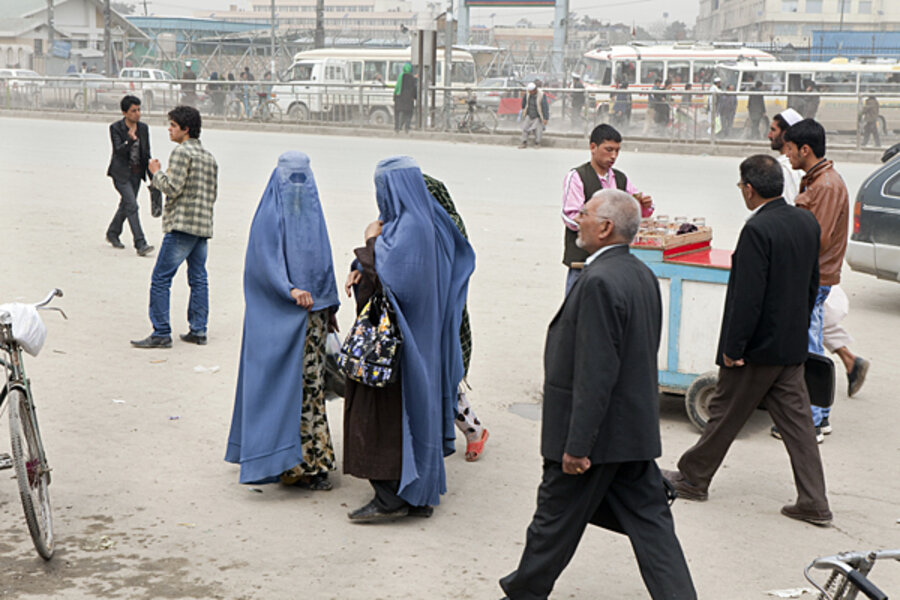USAID to put $300 million into women's rights in Afghanistan
| Kabul, Afghanistan
To a visitor wandering through the streets of Kabul – a capital city with an international airport, a multi-story shopping mall, and a population of 3.2 million – the blue ghosts are hard to ignore. The city’s sidewalks are full of them: figures shrouded in burqas – long swathes of cloth that cover the wearer completely, apart from a small scrap of mesh fabric in front of the eyes that offers a window onto the world outside.
Those ghosts of Kabul, all of whom are women, are less common today than when Afghanistan was under the Taliban’s rule in the 1990s, when it was against the law for a woman to leave her house unless she was wearing a burqa. And today, there are almost as many women on the streets of Kabul who wear headscarves that leave their faces, if not their hair, exposed.
But while the standing of women in Afghan society has improved in some ways since the dark days of the Taliban, thanks in part to the work of international aid agencies and nongovernmental organizations, much is left to be done: Literacy rates among Afghan women hover around 12 percent; more than 90 percent of women here believe that their husbands are justified in beating them if they misbehave, and there are tremendous cultural hurdles to leap along the way.
The latest, biggest move on Afghan women’s issues is coming from the US government. The United States Agency for International Development (USAID) announced in 2012 that it plans to spend $313 million to support the development of Afghan women over the next five years.
It is a massive undertaking in terms of the sheer amount of money, which is more, observers say, than anything that has been spent on women’s issues in the past in this country. But the project also faces serious challenges, in terms of security, management, and execution.
“It’s encouraging that the US is showing that kind of long-term commitment to Afghan women … but nobody knows what’s going to happen over the next five years,” says Louise Hancock, the head of policy and advocacy at Oxfam Afghanistan. “It’s a shame that they didn’t look at doing this kind of project earlier when there would have been a greater chance of success.”
Tenuous time for Afghanistan
With most international forces due to leave Afghanistan by the end of 2014, no one knows what the security situation will look like two years from now. The Taliban and other insurgent groups still control many rural areas of Afghanistan, and their suicide attacks have struck Kabul at a rate of at least once a month over the past few years.
Things could become even more complicated if Afghanistan’s government, which is currently led by President Hamid Karzai, reaches out to conservative groups to further the peace process after international forces leave.
Such considerations led one nongovernmental organization, the Afghanistan Human Rights and Democracy Organization, to conclude in a 2012 report that “most of women’s important achievements over the last decade are likely to be reversed” after 2014.
The USAID project, called Women in Transition, aims to further women’s rights at precisely this challenging time.
Supporting Afghan women could “greatly improve the country’s development prospects during and after Transition,” USAID said in a 300-page draft document that was released in January. “It is the ideal moment in time to substantiate the [US government’s] pledge to Afghan women that ‘we will not abandon you!’”
The project is certainly ambitious in scope: Among its many goals, it aims to place 7,500 young women in government internships; offer business training for women entrepreneurs; help Afghan universities develop women’s studies curricula; and give promising young women the chance to meet female leaders who might serve as role models.
‘Brilliant’ concept, but will it work?
“The concept is brilliant,” says Farkhundah Naderi, a female Afghan parliamentarian, after reviewing the USAID document that offers details on the project. “But I hope there is going to be very strong monitoring,” she added. “At the end of the day, effectiveness is so important.”
That’s an element that hasn’t always been present in previous foreign aid projects that have aimed to help Afghan women, Ms. Naderi says. At the same time, the constant push on women’s rights since the fall of the Taliban has left some Afghans with a bitter taste in their mouths.
“For 11 years they have heard ‘women’s rights, women’s rights, women’s rights,’ and they cannot see that much difference in their lives,” Naderi says, adding that “men are jealous” of the attention that has been showered on women.
That raises the larger question of whether aid agencies and other foreign actors can truly influence attitudes in a society that has so long treated women as second-class citizens.
Building long-term relationships at the community level is critical to changing people’s mindsets, says Chona Echavez, the deputy director for research at the Afghanistan Research and Evaluation Unit, an NGO based in Kabul. Over time, Ms. Echavez says, she has seen Afghan men adjust their views on how women should be treated, especially when they have been presented with hard data on topics like women’s health.
“People should not just say because of tradition, because of culture, because of security, we cannot do this,” Echavez says. “It’s really a process … there are no shortcuts.”








